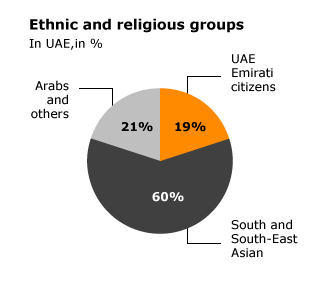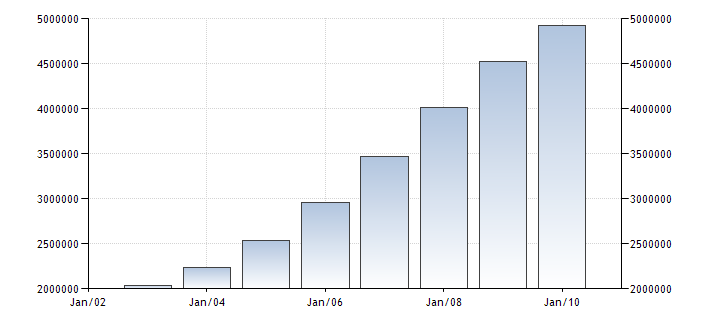Abstract
Economic risk analysis of the UAE shows that it lacks serious economic threats to the Road Pavement Management Industry. The GDP has risen in the past few years. The population that can provide the required labor for the company has increased. Inflation rates remain low. Oil and hydrocarbon trades have generated large revenues and surplus to keep the balance of payment in positive positions and eliminate taxes of businesses. The financial market is stable for investors. Taxes are low in the UAE, but a foreign pavement company may not get the same treatment as local ones. Moreover, foreigners cannot easily own land and can only own 49 percent of their investments. The R&D in the UAE may not favor the growth of the pavement company due to poor performances. The pavement company can use available media to promote its work.
Introduction
This market report presents economic risk analysis of United Arabs Emirates for potential investment in the Road Pavement Management Industry. The report covers population characteristics, economic data and activities, developments in science and technology, channels of distribution, and media.
Population
The UAE National Bureau of Statistics estimated that the total population of the UAE was 8.19 million people in 2010 (National Bureau of Statistics, 2010). The country’s population growth rate was 3.28 percent in the year 2011. A potential investor can rely on this population to provide the required labor for the industry. Most of these populations are concentrated in major urban centers of the UAE where the pavement company can establish its operations. Abu Dhabi has an estimated population of 2.9 million people while Dubai has 2.4 million people.
The large number of qualified migrants would provide technical skills for the company. The Bureau’s data show that nearly 88.5 percent of the populations are expatriates while Emiratis are only 947,997 (11.5 percent). Ethnic composition includes Emiratis and foreign expatriates from different regions, which represent over 150 nationalities. The ethnic composition will provide the company with diverse workforce for the international market.
Economic statistics and activity
The UAE’s GDP or PPP is $258.8 billion and grows at the rate of 4.9 percent according to the Heritage Foundation (Heritage Foundation, 2013). The per capita income is $48,158, but there is not data on average family income. This growth shows the UAE provides a good opportunity for investors.
The country has several modes of transport, which includes water, land, and air. The UAE experiences one of the worst traffic jams in the world, particularly in Abu Dhabi and Dubai. Nevertheless, there are plans to upgrade road and public means of transport. The usage rates of surface transport have increased significantly as the number of middle-class increases. Conversely, availability of public means of transport is now strained.
Therefore, the Road Pavement Management Industry will grow steadily in the UAE due to plans to upgrade the road networks. The UAE requires constructors because the industry has grown steadily in the recent few years.
There are no relevant data, which capture employer and employee relations in the UAE, but Fanack notes that a vast difference in income is widespread. Moreover, foreigners earn poor wages and do mainly hard, unskilled job (Fanack, 2011). Foreign workers “do not benefit from welfare programs available to Emiratis” (Fanack, 2011). This policy also affects areas related to “employees’ salaries, labor rights, promotion, compensation, and other socio-economic benefits” (Fanack, 2011). It is pure discrimination of foreigners. The road pavement company will have to follow laws and regulatory requirements in the UAE labor industry. This would allow the company to operate with legal challenges from Emiratis or expatriates.
In relation to the Road Pavement Management Industry, it is imperative for a new firm to focus on the real estate and construction sectors. Although oil accounts for over 30 percent of the country’s GNP, the UAE expects non-oil sectors to grow due to the ongoing diversification (UAE Interact, 2013b). The country adopted Emiratization policy in which the state and citizens control or work in the most meaningful industries, but there are no data on ownership of public and private industries. Emiratis must own at least 51 percent of all foreign firms. Any investor in the Road Pavement Management Industry must understand business laws of the UAE regarding ownership and managerial positions the company would reserve for Emiratis.
There are foreign investment opportunities in the UAE. These opportunities exist in transport and communication sector and real estate for the Road Pavement Management Industry. Opportunities and success in these sectors have made the UAE to be the most preferred investment hub in the Middle East. The Heritage Foundation notes that FDI inflow in the UAE is $7.7 billion (Heritage Foundation, 2013).
Some of the major imports in the UAE, which could enhance the growth of the company, include transport equipment and machinery (UAE Embassy’s Trade and Commercial Office, 2013). The trend has increased in the past due to the growth of construction industry in the UAE.
The balance of payment situation in the UAE depends on “oil prices and activities in the non-hydrocarbon exports” (UAE Interact, 2013b). Current report predicts that the UAE surplus will continue to rise, and it could reach 10.4 percent of the GDP in 2013 (UAE Interact, 2013b). This limit taxes on business.
The UAE dirham is pegged against the US dollar at 3.6. Nevertheless, the dirham remains strong and stable against the US dollar and other foreign currencies. The stability of the UAE financial market indicates that investors will operate in a stable environment without restriction. Infrastructural development in the UAE has contributed to this stability. This implies that many construction firms are successful in the UAE due to increased demands for their services.
There are few trade restrictions in the UAE, but the general trade atmosphere is fair. The Heritage Foundation notes, “trade-weighted average tariff rate is modest at 3.7 percent, but some non-tariff barriers add to the cost of trade” (Heritage Foundation, 2013). The government restricts abilities of foreigners to invest in land, and they do not receive any treatments compared to Emiratis. The UAE nationals must own at least “51 percent of all foreign business” (Heritage Foundation, 2013). The financial market is competitive and vibrant with several services, but the influence of the government is considerable. The Road Pavement Management Industry must note these challenges and formulate effective strategies of implementing the UAE.
The UAE has some favorable conditions for both startups and existing business. For instance, the UAE has “no income tax and no federal-level corporate tax” (Heritage Foundation, 2013). This has attracted many foreign workers and investors. However, there are some elements of corporate taxes, but there are no general taxes from sales. The UAE has a low tax burden of 7.1 percent of the domestic income. State spending is also low at 22.3% of the GDP. The pavement road company will get tax advantages when investing in the UAE.
In addition, regulation on establishing a business has improved with no minimum capital required. The country has streamlined licensing procedures and reduced costs considerably. This implies that the company would start the business with any amount of capital and get required business permits. These changes in the economic environment of the UAE have improved investment opportunities in the country.
The labor force in the UAE consists mainly of foreigners. Emiratis mainly work in the public sector. There were 4,929,831.47 people employed in the year 2010 (Trading Economics, 2013). The UAE has flexible labor laws with moderate salaries, which would allow the company to seek for highly qualified employees at favorable compensation. Hence, companies would be able to maximize returns and profits in the UAE. On the other hand, the UAE inflation rate is 0.9 percent, but this has increased in the past few years (Heritage Foundation, 2013).
Developments in science and technology
Developments in science and technology in the UAE remain weak. Moreover, the region has a low number of patents (Hanafi, n.d). Foreigners are responsible for the spread of technologies in the UAE. Currently, modern technologies are in the UAE. This suggests that the Road Pavement Management Industry may not get the required expertise or skills if it will rely on advanced equipment for pavement construction. Hence, the company may focus on highly trained foreigners to run its equipment.
Channels of distribution (macro analysis)
Alpen Capital notes that the retail sector in the UAE is the most developed in the Middle East region (Alpen Capital, 2011). The company may get construction equipment and machinery at affordable rates in vibrant retail markets.
Media
All forms of media exist, and they have grown steadily in the UAE. The Road Pavement Management Industry could use magazines, newspaper, satellite, radio, terrestrial television, and online media platforms to promote its pavement construction beyond the UAE. There are also major international media agencies in the UAE, which could give the company international exposure.
Executive summary
The economic risk analysis of the UAE shows that the Road Pavement Management Industry can invest in the country with minimal risks. Several economic factors indicate that the UAE will growth steadily in the subsequent years, especially in the construction and real estate sectors because of the rising populations, increase in salaries of civil servants, and foreign migrants. For instance, the GDP has grown with low rates of inflation. Imports of machinery and equipment have increased. Mixed ethnicity can provide a diverse workforce at moderate costs due to low labor costs and flexible labor laws. The UAE has a positive balance of payment, and it continues to rise due to surplus from the oil revenues. There are trade restrictions, especially in ownership of land. Moreover, Emiratis must own more than 51% of foreign firms in the UAE. Taxes remain low, but some non-tariff barriers exist. Generally, the UAE has poor records in R&D. Hence, the company will rely on foreigners to run technical operations. The retail sector thrives with largest shopping malls in urban centers. The UAE has all media, which the Road Pavement Management Industry could use to promote the business.
References
Alpen Capital. (2011). GCC Retail Industry. Web.
Fanack. (2011). Income distribution. Web.
Hanafi, S. (n.d). The Science and Technology Profile of the United Arab Emirates. Web.
Heritage Foundation. (2013). 2013 Index of Economic Freedom: United Arab Emirates. Web.
National Bureau of Statistics. (2010). Population leaps to 8.19 million. Web.
Trading Economics. (2013). Labor force total in the United Arab Emirates. Web.
UAE Embassy’s Trade and Commercial Office. (2013). Trade & Export. Web.
UAE Interact. (2013a). Humanitarian Aid. Web.
UAE Interact. (2013b). The Economy. Web.
Appendixes


